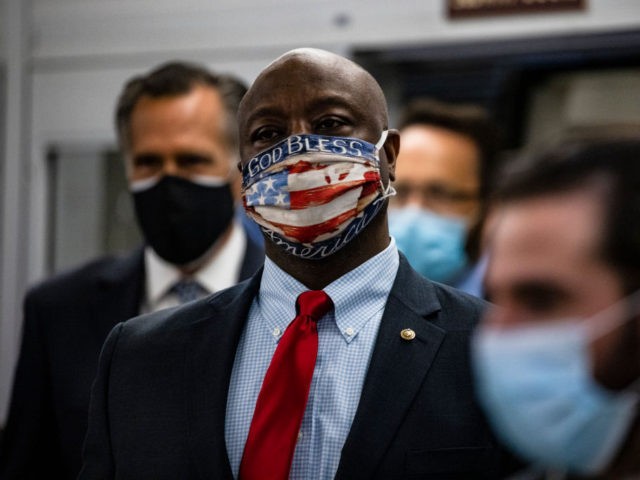Sen. Tim Scott (R-SC) covered up the party’s disagreement over migration and wages during his prime-time response to President Joe Biden’s address to Congress.
“The Republicans should have made a bigger issue of it, not only hammering the border [crisis] … but in specifically criticizing excessive immigration and its effect on working Americans,” said Mark Krikorian, director of the Center for Immigration Studies. “They still haven’t learned the lesson; they still haven’t fully internalized the political imperative and the policy imperative of populism,” he added.
Scott responded to Biden’s downbeat, low-key speech by championing the United States’ open culture and by touting the U.S. economy during President Donald Trump’s tenure.
But the South Carolina Republican excluded Trump’s lower-immigration/higher-wage policies from his explanation for Trump’s good economy:
Just before COVID, we had the most inclusive economy in my lifetime. The lowest unemployment rate ever recorded for African Americans, Hispanics, and Asians and a 70-year low — nearly — for women. Hear me — wages were growing faster for the bottom than at the top. The bottom 25 percent saw their wages rise faster than the top 25 percent.
That happened because Republicans focused on expanding opportunity for all Americans.
But he cited non-immigration policies pushed by himself and other GOP legislators:
In addition to that, we passed Opportunity Zones, criminal justice reform, and permanent funding for Historically Black Colleges and Universities for the first time ever. We fought the drug epidemic, rebuilt our military and cut taxes for working families and single moms like the one that raised me.
Trump’s lower-migration policy pressured companies to pay higher wages, invest in labor-saving machines, and recruit long-ignored Americans with disabilities, criminal convictions, or the bad luck of growing up in high-unemployment backwaters.
“For Americans to be able to obtain well-paying careers, affordable housing, good schools, overall quality of life, immigration to the U.S. should be reduced,” NumbersUSA responded by tweet to Scott. “As long as the field is tilted to wealthy who run [the] political system, the American people will always lose out,” the immigration reform group said.
“Republican politicians generally believe what they’re saying,” Krikorian said. But, he added:
They are still in the thrall of 1980s thinking about immigration and the economy. Some of them have broken out of that frame, but many of them haven’t. Obviously, business donors still retain a lot of influence, but the Republican Party is in the process of evolving, and Scott’s talk suggests that that evolution is incomplete.
Scott’s comments match the don’t-mention-the-money talking points posted by the donor-funded establishment GOP.
For example, an April 26 memo by multiple pollsters for the National Republican Congressional Committee portrayed the migration issue as merely a “border crisis” instead of a threat to Americans’ livelihoods.
The memo for the committee, which relies on wealthy donors to help provide campaign funds for House GOP races, declared:
Immigration and border security is now the most important issue for President Biden and Congress to focus on. Concern about the border has increased from 11% in February to 28% now, and border security now ranks ahead of jobs and the economy (24%) as the most important issue.
Similarly, pollster Frank Luntz was invited to brief GOP legislators about “messaging guidance on hot topics” during the GOP’s policy meeting in Florida on April 27. On April 25, Luntz described his pitch to Axios’s Mike Allen:
Complete the building of a physical barrier between the U.S and Mexico to ensure border security, and pass the DREAM Act, which will give the children of undocumented workers the chance to earn citizenship over time.
That amnesty-for-concrete pitch ignores jobs and wages, but it would help establishment lobbyists — aided by former President George W. Bush — to push for a bigger bill that could help lower wages and raise housing prices nationwide.
Both Scott and Biden also minimized their mention of the current border crisis, despite the growing flood of low-wage workers and their dependents who are being admitted by Biden’s border deputy, Alejandro Mayorkas, the secretary at the Department of Homeland Security.
“Weakening our southern borders and creating a crisis is not compassionate,” said Scott.
“Given how much Republicans have focused on it over the first 100 days, it’s interesting that Tim Scott only mentioned the border in just one passing reference. Once,” tweeted Robert George, an opinion columnist at Bloomberg News.
The flood of low-wage migrants, taxpayer-mixed consumers, and high-occupancy renters is being welcomed by business groups and their allies in the immigration business. “My quality of life, and the quality of life of pretty much everyone I know, would go down if immigration to the United States was reduced,” said a taunting tweet from Aaron Reichlin-Melnick, an advocate at the Immigration Council, which is a spin-off of the American Immigration Lawyers Association.
For many years, a wide variety of pollsters have shown deep and broad opposition to labor migration and the inflow of temporary contract workers into jobs sought by young U.S. graduates.
This opposition is multiracial, cross-sex, non-racist, class-based, intra-Democratic, rational, and recognizes the solidarity that Americans owe to each other.
The voter opposition to elite-backed economic migration coexists with support for legal immigrants and some sympathy for illegal migrants. But only a minority of Americans — mostly leftists — embrace the many skewed polls and articles pushing the 1950’s corporate “Nation of Immigrants” claim.
The deep public opposition to labor migration is built on the widespread recognition that legal and illegal migration moves money away from most Americans’ pocketbooks and families.
Migration moves money from employees to employers, from families to investors, from young to old, from children to their parents, from homebuyers to investors, from technology to stoop labor, from red states to blue states, and from the central states to the coastal states such as New York.

COMMENTS
Please let us know if you're having issues with commenting.